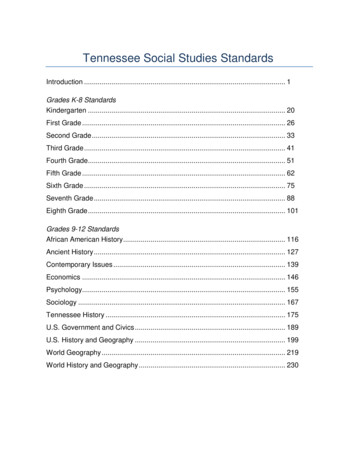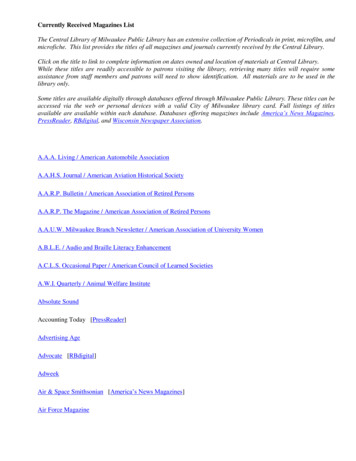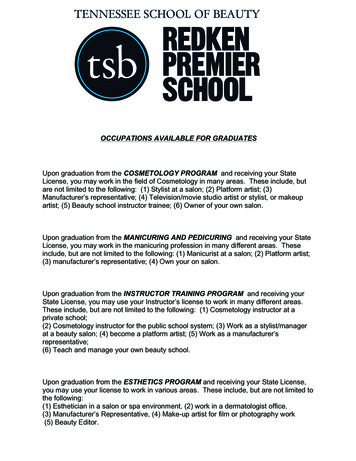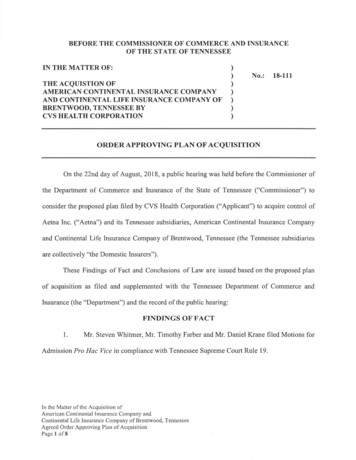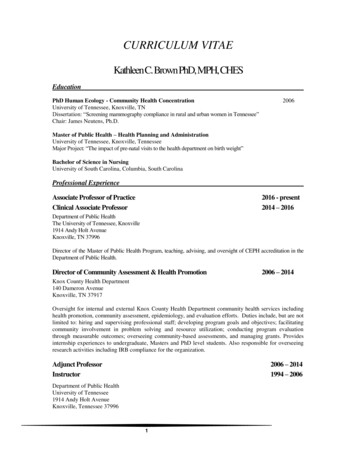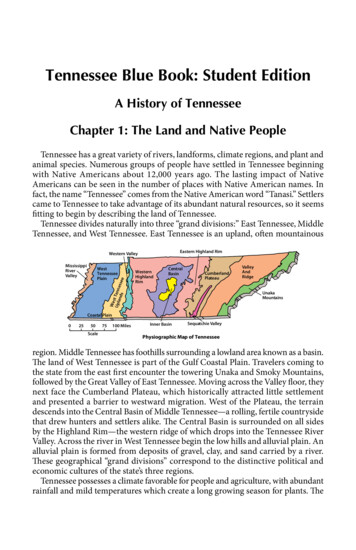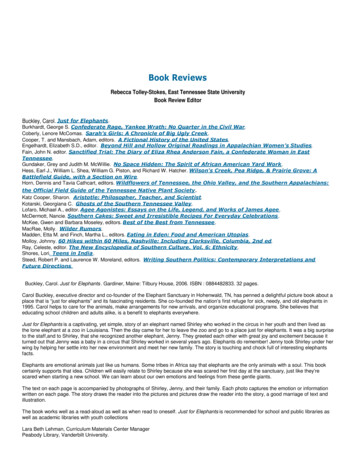
Transcription
Book ReviewsRebecca Tolley-Stokes, East Tennessee State UniversityBook Review EditorBuckley, Carol. Just for Elephants .Burkhardt, George S. Confederate Rage, Yankee Wrath: No Quarter in the Civil War.Coberly, Lenore McComas. Sarah’s Girls: A Chronicle of Big Ugly Creek.Cooper, T. and Mansbach, Adam, editors. A Fictional History of the United States.Engelhardt, Elizabeth S.D., editor. Beyond Hill and Hollow Original Readings in Appalachian Women’s Studies.Fain, John N. editor. Sanctified Trial: The Diary of Eliza Rhea Anderson Fain, a Confederate Woman in EastTennessee.Gundaker, Grey and Judith M. McWillie. No Space Hidden: The Spirit of African American Yard Work.Hess, Earl J., William L. Shea, William G. Piston, and Richard W. Hatcher. Wilson's Creek, Pea Ridge, & Prairie Grove: ABattlefield Guide, with a Section on Wire.Horn, Dennis and Tavia Cathcart, editors. Wildflowers of Tennessee, the Ohio Valley, and the Southern Appalachians:the Official Field Guide of the Tennessee Native Plant Society.Katz Cooper, Sharon. Aristotle: Philosopher, Teacher, and Scientist.Kotarski, Georgiana C. Ghosts of the Southern Tennessee Valley.Lofaro, Michael A., editor. Agee Agonistes: Essays on the Life, Legend, and Works of James Agee.McDermott, Nancie. Southern Cakes: Sweet and Irresistible Recipes For Everyday Celebrations.McKee, Gwen and Barbara Moseley, editors. Best of the Best from Tennessee.MacRae, Molly. Wilder Rumors.Madden, Etta M. and Finch, Martha L., editors. Eating in Eden: Food and American Utopias.Molloy, Johnny. 60 Hikes within 60 Miles, Nashville: Including Clarksville, Columbia, 2nd ed.Ray, Celeste, editor. The New Encyclopedia of Southern Culture. Vol. 6: Ethnicity.Shores, Lori. Teens in India.Steed, Robert P. and Laurence W. Moreland, editors. Writing Southern Politics: Contemporary Interpretations andFuture Directions.Buckley, Carol. Just for Elephants . Gardiner, Maine: Tilbury House, 2006. ISBN : 0884482833. 32 pages.Carol Buckley, executive director and co-founder of the Elephant Sanctuary in Hohenwald, TN, has penned a delightful picture book about aplace that is “just for elephants” and its fascinating residents. She co-founded the nation’s first refuge for sick, needy, and old elephants in1995. Carol helps to care for the animals, make arrangements for new arrivals, and organize educational programs. She believes thateducating school children and adults alike, is a benefit to elephants everywhere.Just for Elephants is a captivating, yet simple, story of an elephant named Shirley who worked in the circus in her youth and then lived asthe lone elephant at a zoo in Louisiana. Then the day came for her to leave the zoo and go to a place just for elephants. It was a big surpriseto the staff,and to Shirley, that she recognized another elephant, Jenny. They greeted each other with great joy and excitement because itturned out that Jenny was a baby in a circus that Shirley worked in several years ago. Elephants do remember! Jenny took Shirley under herwing by helping her settle into her new environment and meet her new family. The story is touching and chock full of interesting elephantsfacts.Elephants are emotional animals just like us humans. Some tribes in Africa say that elephants are the only animals with a soul. This bookcertainly supports that idea. Children will easily relate to Shirley because she was scared her first day at the sanctuary, just like they’rescared when starting a new school. We can learn about our own emotions and feelings from these gentle giants.The text on each page is accompanied by photographs of Shirley, Jenny, and their family. Each photo captures the emotion or informationwritten on each page. The story draws the reader into the pictures and pictures draw the reader into the story, a good marriage of text andillustration.The book works well as a read-aloud as well as when read to oneself. Just for Elephants is recommended for school and public libraries aswell as academic libraries with youth collectionsLara Beth Lehman, Curriculum Materials Center ManagerPeabody Library, Vanderbilt University.
Tennessee Library Association2 of 10http://www.tnla.org/displaycommon.cfm?an 1&subarticlenbr 152&prin.Burkhardt, George S. Confederate Rage, Yankee Wrath: No Quarter in the Civil War. Carbondale: Southern Illinois University Press, 2007.ISBN: 0809327430. 384 pages.George S. Burkhardt’s well researched and interesting book, Confederate Rage, Yankee Wrath, details an important yet underwritten aspectof the Civil War. Burkhardt examines the rage felt by Confederate soldiers at former black slaves for fighting against them as equals afterLincoln’s Emancipation Proclamation in 1863. He uses this motivation as part of his proof that the Confederate killings of black prisoners ofwar, and some white Federal soldiers, were not random massacres, but a standard policy practiced throughout much of the war. Burkhardtspecifically examines Fort Pillow which was fought by men who served under General Nathan Bedford Forrest and the Shenandoah Valleyof Virginia which was a major staging area for Confederate troops during the Civil War. His book is organized into easy to understandsections, and the influx of primary sources makes it credible and appealing. Tennessee libraries will be interested in adding this to theirgeneral history collection as a portion of the text deals with Fort Pillow, Tennessee, about forty miles north of Memphis. Recommended foruniversity collections and those libraries with strong Civil War collections.Claire Stults, Assistant Reference LibrarianWilliamson County Public Library Franklin, TNCoberly, Lenore McComas. Sarah’s Girls: A Chronicle of Big Ugly Creek. Athens: Shallow/Ohio University Press, 2007. ISBN:0804010951. 157 pages.Sarah’s Girls is a fictionalized account of the author’s ancestors from the Appalachian town of Big Ugly. The book focuses on the lives ofSarah and Philip Hager and their daughters, Madge, Pearl, Ida, and Edna. It begins with Philip coming to the town of Big Ugly, WestVirginia and looking for strong men to work at his timber cutting business venture so that he may earn money to become a doctor. Duringthis labor search, Philip meets, and instantly falls in love with, Sarah Ferrell. Since Sarah refuses to leave Big Ugly, Philip gives up hisdreams of moving to a big city for a better life to marry Sarah and settle down in Big Ugly. Philip and Sarah subsequently bear four beautifuldaughters and make a nice life for themselves; although Philip still harbors the dream of moving to a city like Charleston, West Virginia andgetting involved in politics. Unfortunately, Sarah, frequently described as a delicate and fragile woman, dies when her daughters are stillyoung. After his beloved wife’s death, Philip decides it is best for him and his daughters to move to the city of Hamblin, where the girls canearn a better education and Philip can make a better living. The majority of the book’s action follows the Hager family’s life after their moveto the city and is interspersed with brief cuts to what other family members, such as Sarah’s sister Lena, are doing back at Big Ugly. Thebook’s narrative is also frequently broken up with letters from the girls to their relatives back in Big Ugly and aspiring writer Pearl’s journalentries and other writings.I was drawn into the lives of Philip and his daughters and caring what happened to them, but I did not find the book to be very well written.The dialog was especially abrupt and juvenile. I wondered why I should care about reading a book about a stranger’s relatives in the firstplace. Despite all of those flaws, though, I did want to know how things turned out for everyone, and this book also provides good insightinto close-knit family and city life at the turn of the twentieth century.Even though Sarah’s Girls is about real people, it is a book of fiction, and therefore, is not intended for any kind of research purposes. Iwould not recommend this book for any library, except possibly for the juvenile fiction section of a public library. Young fans of historicalfiction like Laura Ingalls Wilder and the American Girl books might enjoy this book, but unless someone personally knows the author, I donot think anyone else will be interested.Julie Caudle, Head LibrarianSpring Hill Public LibraryCooper, T. and Mansbach, Adam (eds). A Fictional History of the United States With Huge Chunks Missing. New York: Akashic Books,2006. ISBN: 193335402X. 331 pages.This collection of seventeen never-before-published stories is linked very tenuously to events in American history. This is a clever idea. Thereader is pulled along from story to story and a motley collection is given some shape.There are some stand outs. Alexander Chee describes how Chinese travelers are trapped in the new world and become First Peoples. RonKovic packs a lot of punch into seven pages in "The Recruiters" and is recommended reading for any young person thinking of joining theMarines.David Rees and David Knight use graphics to make their points. Valerie Miner reminds us of the eerie similarities between the paranoia ofthe 1950s and our post 9/11 fears.You may recognize many of the authors' names. While this is not always their best work it is nice to know what they are up to these days. AFictional History of the United States With Huge Chunks Missing should be purchased by libraries whose patrons just cannot get enoughshort fiction.Willa Reister, Interlibrary LoanKnox County Public Library System1/30/2008 9:17 AM
Tennessee Library Association3 of 10http://www.tnla.org/displaycommon.cfm?an 1&subarticlenbr 152&prin.Engelhardt, Elizabeth S.D., editor. Beyond Hill and Hollow Original Readings in Appalachian Women’s Studies. Athens: Ohio UniversityPress, 2005. ISBN:0.821415778. 260 pages.The overall content and purpose of the monograph presents the hardships suffered and perseverance, to not only survive but succeed, ofwomen of Appalachia. For example, the book includes the fears of death of husbands while coal mining, feuds, challenging the stereotypesof mountain females, poor disadvantaged mountain women becoming ladies of the evening, and comparisons of Appalachia females to thepoverty-stricken females of Bolivia. Revelations from books such as Sharyn McCrumb’s She Walks These Hills educate readers.This exhaustively and accurately researched book is comprised of a series editor’s preface, a preface, an acknowledgments, twelve essaysby twelve authors, two pages listing the contributors, and a precise index.Chapter nine “Appalachian Women and Language Old and New Forms as Reflections of a Changing Image” includes four maps of dialect inAppalachia. Each powerful and chapter ends with a studied listing of Notes. The book is divided into three sections including “Voices ofActivism” with three chapters, “Voices of Class” composed of four chapters, and “Voices of Place” containing four chapters.The intended audience is anyone interested in the struggles and conflicts of females of Appalachia. Clearly, Beyond Hill and Hollowenormously and vitally contributes to the fields of women’s studies, sociology, social work, psychology, and history. Any academic library,public library, or special history collection of Appalachia should purchase and would invaluably benefit from .Melinda F. Matthews, Interlibrary Loan/Reference LibrarianUniversity of Louisiana at MonroeFain, John N. ed. Sanctified Trial: The Diary of Eliza Rhea Anderson Fain, a Confederate Woman in East Tennessee. Knoxville: Universityof Tennessee Press, 2004. ISBN: 1572333138. 410 pages.This diary of Eliza Rhea Anderson Fain describes the Civil War as it was for the female civilians and slaveholders in East Tennessee.Edited by a relative, John N. Fain, it gives a unique picture of the every day life of the people caught up in the war, especially those in one ofthe “border” states like Tennessee, where your neighbor might also be your enemy. Eliza was a wife, a mother to 13 children, aConfederate sympathizer, and a deeply religious woman. Her deep convictions about the Biblical rightness of slavery give an interestingview of the southern thinking at the time. With great pride, she sent her husband and five of her sons to war. All survived, but she agonizedover those of her acquaintance who did die for the cause.Eliza shows the strength and resiliency of the women of that time, whose comfortable lives were shattered by the war. She clothed and fedher family in spite of the invading army and bushwhackers who plundered her home. Neighbors helped neighbors whenever possible andthey were also the main source of communication for each other. Eliza’s deep religious faith and belief in the rightness of the Southerncause shine through in every entry of this amazing diary.An incredible number of people touched her life on a daily basis, so an annotated list of the “Principle Characters in the Diary” and many wellresearched footnotes added by the editor are invaluable aids. And the extensive bibliography and index are also very helpful. Although afew maps are included in the preface material, they could be more detailed and inserted more appropriately. Recommended for academicand public libraries and for anyone interested in the Civil War, especially in Tennessee.Sue AlexanderJames E. Walker Library, Middle Tennessee State UniversityGundaker, Grey and Judith M. McWillie. No Space Hidden: The Spirit of African American Yard Work. Knoxville: University of TennesseePress, 2005. ISBN 1572333561.237pp.In No Space Hidden, Grey Gundaker (Associate Professor of Anthropology and American Studies, College of William & Mary) and JudithMcWillie (Professor of Painting and Drawing, University of Georgia’s Lamar Dodd School of Art) provide, through photographs, backgroundhistory and personal narratives of the southeastern African Americans who created these landscapes, a window onto the meaning andplacement of materials used to “decorate” their yards. The book further suggests there are cultural threads running through “yard work” thatreflect a global connection between the “practitioners” and their African, Caribbean, European, and Native American ancestors. The threadcan be traced through themes, materials, imagery and organization of yards.Driving through some areas of the Southeast, one may view yards filled with specifically arranged pieces of concrete, bottles, masks, brightshiny objects, metals and other objects of various materials and colors. This book suggests that the yard is not filled with junk but withcarefully placed materials that are signs to commemorate, communicate, instruct, and warn, remind and admonish those who view them. Infact, these yard works have been viewed as outsider art or folk art and have created quite a stir in the art world. But these practitioners aredoing more than creating art. They are making a statement about themselves, their community and how they live their lives responsiblywithin the community and society. There is also spiritual meaning in the yards created by these artist philosophers. These yards reflect theglobal connection as well as the individuality, creativity and philosophy of the owner.This book acts as a personal guide through the yards, by providing biographical information about and first person conversations with theartists. It is an illustrated seminar in outsider art and anthropology, which informs of the spiritual, hidden and symbolic meanings, the richculture and the histories these practitioners and their yards of bottles, wheels, sculptures, glass and found materials represent.1/30/2008 9:17 AM
Tennessee Library Association4 of 10http://www.tnla.org/displaycommon.cfm?an 1&subarticlenbr 152&prin.A unique feature of this book is an introductory portfolio to each of its six chapters. The portfolio contains most of McWillie’s photographs ofthe yard work and many of the stories and personal narratives of the artists, while the chapters expound on the specific themes, materialsand meanings represented in the portfolio. There are very informative notes for each chapter and portfolio. For further reading, there is anexcellent selected bibliography.No Space Hidden would be useful for public libraries with regional history and art collections and for academic libraries with AfricanAmerican Studies, American Studies, anthropology, or art history collections.Sharon JohnsonFelix G. Woodward Library, Austin Peay State UniversityHess, Earl J., William L. Shea, William G. Piston, and Richard W. Hatcher. Wilson's Creek, Pea Ridge, & Prairie Grove: A BattlefieldGuide, with a Section on Wire Road. This Hallowed Ground: Guides to Civil War Battlefields. Lincoln: Bison Books, University of NebraskaPress, 2006. ISBN 0803273665 288 pages.Part of the This Hallowed Ground: Guides to Civil War Battlefields series, this text provides the reader with a practical guide to three of theTrans-Mississippi Theater’s most significant battles, Wilson's Creek, Pea Ridge, and Prairie Grove, as well as the Wire Road, a primarymeans of travel and communication in Southwest Missouri and Northwest Arkansas. A combination of authoritative writing and detailedbattlefield analysis makes this a wonderful tool to understand how these battles unfolded and fit within the conflict over possession ofArkansas and Missouri. Anyone researching these events or traveling to the respective locations needs to read this work.Four leading scholars combine to provide masterful analysis of these sites. Earl J. Hess, the Stewart McClelland Chair of History at LincolnMemorial University, tackles the Battle of Pea Ridge, now preserved as the Pea Ridge National Military Park. The Battle of Prairie Grove,interpreted on the state level as the Prairie Grove Battlefield Park, is the subject of University of Arkansas Monticello professor of historyWilliam L. Shea’s section. William G. Piston, professor of history at Missouri State University, and Richard Hatcher, historian at the FortSumter National Monument, combine their expertise to analyze the Battle of Wilson’s Creek, also a national park called the Wilson’s CreekNational Battlefield. Hess writes the section on the Wire Road with valuable input from Piston and Shea, who focus upon stretches betweenSpringfield and Madry, Missouri, and Dripping Springs and Van Buren, Arkansas, respectively.To navigate the reader to these locations, the text is divided into a series of stops which require walking, and sites requiring less movementcalled substops. At each of these locations, the text uses the following terminology to describe the events and place the reader in the properlocation: “Direction,” “Orientation,” “What Happened,” “Analysis,” and “Vignettes” “Direction” navigates drivers between stops and“Orientation” sets the viewer in the correct location to view the ground. “What Happened” and “Analysis” explain the overall importance ofthe site in relation to actual movements in the overall importance in the battle or campaign. “Vignettes” make the events moreunderstandable by providing the readers with personal stories of the locations. Furthermore, the text contains numerous maps,photographs, and images to aid in describing the events, persons, and locations in these battles.Overall, the writing and methodology make the text extremely flexible. The reader may frame the battles within the geography ofNortheastern Arkansas and Southeastern Missouri to better understand the campaigns or focus on the movements within small areas on thebattlefield. With this said, only one criticism exists. Both in reading and following the stops, the text is occasionally out of chronological order,causing some confusion for the inattentive reader. Nonetheless, the work is an excellent account of the location and events. It is highlyrecommended for the bookshelves of both academic and general libraries as Civil War scholars, enthusiasts, and novices will find it helpfulin understanding these events.Derek Allen ClementsBlack River Technical College, Pocahontas, ArkansasHorn, Dennis and Tavia Cathcart, editors. Wildflowers of Tennessee, the Ohio Valley, and the Southern Appalachians: the Official FieldGuide of the Tennessee Native Plant Society. Auburn, WA: Lone Pine Publishing, 2005. ISBN 1551054280 ages.Prepared under the auspices of the Tennessee Native Plant Society Wildflowers of Tennessee, the Ohio Valley and the SouthernAppalachians is a welcome addition to the world of field guides specific to Tennessee flora and fauna. The title may mislead users to believethat the main focus is not on Tennessee; however, it reflects the editors’ recognition of regional ecosystems in identifying wildflower habitatsrather the state’s political boundaries.The guide describes over 1,250 species with almost 800 color photographs. The quality of the photographs will definitely assist withidentification of flowers in the field. The photographs are also enjoyable to view for the beauty of the flowers. The photo editors, David Duhland Dennis Horn, used the talents of over 50 photographers to create this visual delight.The guide is organized first by plant family followed by subdivisions of genera and species, which are arranged alphabetically. An entry foran individual wildflower includes both the common and scientific names. A flower’s description is categorized by into 6 distinct sections:general, leaves, fruits, where found, similar species, and notes. Section titles are in bold print and the layout is consistent for each entry,which makes it easy to locate pertinent information about a particular flower.The introduction to Wildflowers of Tennessee, the Ohio Valley and the Southern Appalachians provides a good overview of the guide itselfand related wildflower topics, such as the physiographic provinces in the region, and ethnobotany. The guide’s layout is easy to use for alllevels of users. For the novice wildflower enthusiast or casual user there is a 15 page color key to help start the identification process. Thekey has 300 photographs of flowers grouped by color to represent various plant families. The color key refers the user to the appropriate1/30/2008 9:17 AM
Tennessee Library Association5 of 10http://www.tnla.org/displaycommon.cfm?an 1&subarticlenbr 152&prin.page. In addition there are 12 family keys to help establish the genus of particular flower.Wildflowers of Tennessee, the Ohio Valley and the Southern Appalachians is highly recommended for all Tennessee libraries.Livy Simpson,Cataloging/ILL LibrarianThigpen Library,Volunteer State Community CollegeKatz Cooper, Sharon. Aristotle: Philosopher, Teacher, and Scientist. Minneapolis: Compass Point Books, 2007. ISBN: 0756518733.112 pagesAristotle is one of history’s greatest minds and his philosophies have influenced Western thinking from his time to present. Aristotelianteachings were dominant forces in Western education until the late medieval period until finally supplanted by Roger Bacon’s new emphasison the emerging scientific method. Understanding Aristotle’s philosophy is no easy task, but Sharon Katz Cooper presents one of history’sgreat minds in an easily accessible format, especially for younger readers.This work is part the Signature Lives series, a collection of 66 books that details the lives of noteworthy historic figures ranging fromAlexander the Great, Erasmus, Columbus, Hitler, and Eva Peron. Aimed at readers grades 5-7, the series seeks to present persons thatshaped their time and future events by providing information that is fun and entertaining, not overwhelming in specialized jargon. The seriesis colorful and vibrant allowing for the imagination of readers to flower.Sharon Katz Cooper’s overview of Aristotle’s life and times, philosophies, and influences are well researched. The history of ancient Greececomes to life in her work, as do those thinkers and leaders that Aristotle’s teachings impacted. Katz Cooper is no stranger to writing aboutscience and social studies for children; she has authored books in the Exploring Earth’s Resources, Exploring Science, and Country Abcsseries of childrens’ books. Aristotle was instrumental in laying the early foundations for empirical science thus putting him well within arealm that Katz Cooper would understand.One of best features of her work is the sidebars that abound throughout providing additional information about various people, places, andideas that relate to Aristotle. Also, the immense variation of art is very impressive. Art ranging from ancient Greek pottery to medievalilluminated books that depict Aristotle serve to enlighten readers and expose them the artistic movements of the West. The back matterincludes a timeline of Aristotle’s life as compared with major events, short biographical information about Aristotle, a suggested reading listwith additional resources, and a brief glossary of terms. This material is very good as it encourages further exploration of the subject matter.Aristotle: Philosopher, Teacher, and Scientist is a work that should be considered for the childrens’ section of a public library as well as formedia centers in public schools. In fact, other books from the Signature Lives series should also be considered in order to expose youngreaders to many historic figures and influential ideas of the past that still resonate in the present.Jamie B. Price, Reference LibrarianJefferson College of Health SciencesRoanoke, VirginiaKotarski, Georgiana C. Ghosts of the Southern Tennessee Valley. Winston-Salem: John F. Blair, 2006. ISBN 0895873265. 217 pages.Georgiana C. Kotarski, director of the Sequatchie Valley campus of Chattanooga State Technical Community College, has written anenjoyable book that “seek[s] neither to condone nor criticize a belief in ghosts but rather document[s] ghost lore for the entertainment ofbelievers and nonbelievers alike” (xxi). Ms. Kotarski prefaces her collection of tales with a description of how she was commissioned towrite an article about the ghosts of Chattanooga for a local publication. After researching several local legends, she completed the articleand it was published. She related that after the article’s publication, she began to talk with many people who believed that they hadwitnessed or experienced something that they believed was otherworldly. After several years, she says she felt compelled to write aboutthese spirits of the southern Tennessee Valley and share the stories with a wider audience.She credits many specific professors, historians, and librarians with assisting her in her research. She also conducted numerous interviewswith witnesses to possible paranormal phenomena.Ms. Kotarski outlines the scope of this book to include tales from southeastern Tennessee, northwest Georgia, and north Alabama. Shebegins her collection of stories in 1844 in Pikeville, TN with the case of the outlaw John A. Murrell, whose restless spirit began to appearafter his corpse was dug up and decapitated. Other tales from Tennessee include the case of a young girl who lost her life in a tragicaccident and continues to haunt her burial place with her tears; and the case of a friendly "shadow man" who was likely a civil war soldier orveteran. There are several cases from around the Chattanooga area, including one involving the administrative building at the University ofTennessee, Chattanooga; and a case of a possible haunting of a Ruby Tuesday by a young child who liked to play tricks on patrons andstaffTales from Northwest Georgia include those of protective and kind spirits, distressed civil war soldiers, possible demons, and a ghostly oldercouple who continue to haunt the home where they made their lives.Tales from north Alabama include that of a time shifting graveyard and the story of a murder victim who communicated with police officersinvestigating the crime scence of her murder.The history and folklore reported in this book appears to be well researched, although the author does make a point to state that sources do1/30/2008 9:17 AM
Tennessee Library Association6 of 10http://www.tnla.org/displaycommon.cfm?an 1&subarticlenbr 152&prin.not always agree and many versions of the same tale can and often do exist (xx). The inclusion of interviews and first hand accountsgreatly enhance the book. The writing style is very easy to digest. his book does not claim to be the definitive version of ghost tales from thesoutheastern Tennessee area, but it would make a nice addition to local history, folklore, or paranormal collections in public or communitycollege libraries.Jennifer Newcome, LibrarianHardwick—Johnston Memorial Library, Hiwassee CollegeLofaro, Michael A., editor. Agee Agonistes: Essays on the Life, Legend, and Works of James Agee. Knoxville: University of TennesseePress, 2007. ISBN 1572335742. 334 pages.James Agee, Knoxville poet, novelist, screenwriter, columnist, television writer, and lyricist, had many literary talents. His work was recentlyforgotten, but is now experiencing revival. He had a self destructive personality. He wrote with liquor on one edge of the table, andBenzedrine on the other. He also used nitroglycerine, which he took to nurse himself through the small heart attacks which were common.Finally an attack claimed his life in a New York taxi at the age of 48. One wonders what his literary production might have been had he livedlonger. He left many, many works unfinished.The overall content of the work is a commentary on the various literary genres in which Agee was involved, and on his life. The purpose ofthe book is to analyze the influences on his work, and to describe and critique the work itself.Lofaro has written a number of other books concerning not only Agee, but Daniel Boone and Davy Crockett. He is a professor at theUniversity of Tennessee Knoxville. Among his works on Agee are: James Agee Rediscovered: Journals of Let Us Now Praise Famous Menand Other New Manuscripts, The Literary Notebooks of James Age
Rebecca Tolley-Stokes, East Tennessee State University Book Review Editor Buckley, Carol. Just for Elephants. . Wildflowers of Tennessee, the Ohio Valley, and the Southern Appalachians: the

